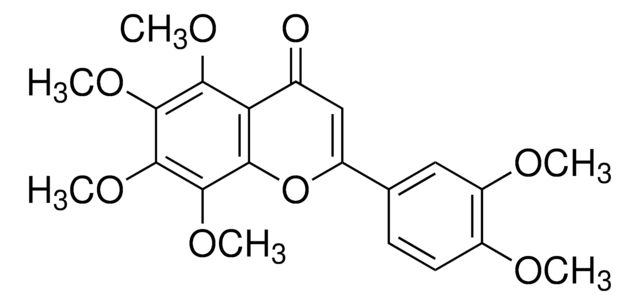SML0953
Cirsiliol
≥90% (HPLC)
동의어(들):
2-(3,4-Dihydroxyphenyl)-5-hydroxy-6,7-dimethoxy-4H-1-benzopyran-4-one, 3′,4′,5-Trihydroxy-6,7-dimethoxy-flavone, 5,3′,4′-Trihydroxy-6,7-dimethoxyflavone, 6,7-Dimethoxy-5,3′,4′-trihydroxyflavone, 6-Hydroxyluteolin-6,7-dimethyl ether, 6-Methoxyluteolin 7-methyl ether, Crisiliol
About This Item
추천 제품
Quality Level
분석
≥90% (HPLC)
형태
powder
저장 조건
protect from light
색상
white to beige
solubility
DMSO: 10 mg/mL, clear
저장 온도
2-8°C
InChI
1S/C17H14O7/c1-22-14-7-13-15(16(21)17(14)23-2)11(20)6-12(24-13)8-3-4-9(18)10(19)5-8/h3-7,18-19,21H,1-2H3
InChI key
IMEYGBIXGJLUIS-UHFFFAOYSA-N
생화학적/생리학적 작용
특징 및 장점
신호어
Warning
유해 및 위험 성명서
예방조치 성명서
Hazard Classifications
Acute Tox. 4 Oral
Storage Class Code
11 - Combustible Solids
WGK
WGK 3
Flash Point (°F)
Not applicable
Flash Point (°C)
Not applicable
시험 성적서(COA)
제품의 로트/배치 번호를 입력하여 시험 성적서(COA)을 검색하십시오. 로트 및 배치 번호는 제품 라벨에 있는 ‘로트’ 또는 ‘배치’라는 용어 뒤에서 찾을 수 있습니다.
관련 콘텐츠
Apoptosis, or programmed cell death (PCD), is a selective process for the removal of unnecessary, infected or transformed cells in various biological systems. As it plays a role in the homeostasis of multicellular organisms, apoptosis is tightly regulated through two principal pathways by a number of regulatory and effector molecules.
n proliferating cells, the cell cycle consists of four phases. Gap 1 (G1) is the interval between mitosis and DNA replication that is characterized by cell growth. Replication of DNA occurs during the synthesis (S) phase, which is followed by a second gap phase (G2) during which growth and preparation for cell division occurs. Together, these three stages comprise the interphase phase of the cell cycle. Interphase is followed by the mitotic (M) phase.
자사의 과학자팀은 생명 과학, 재료 과학, 화학 합성, 크로마토그래피, 분석 및 기타 많은 영역을 포함한 모든 과학 분야에 경험이 있습니다..
고객지원팀으로 연락바랍니다.
